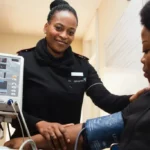Cancers are one of everyone’s greatest medical fear, and for women, Cervical cancer is one that brings that chill down the spine.
This type of cancer develops in the cells of the cervix, which is the lowest portion of the uterus that attaches it to the vagina.
Most cases of cervical cancers are brought on by different strains of the human papillomavirus (HPV), a sexually transmitted infection. Among most of these strains, 16 and 18 are high risk as they have been implicated in many cancer cases.
The immune system of the body usually stops HPV from doing any harm when it is exposed. But in a small proportion of patients, the virus endures for years, aiding in the process that turns certain cervical cells into cancer cells.
Facts about cervical cancer
Here are a few facts about cervical cancer that will help you understand why it is such a big deal.
1. Nigerian women from the age of 15 years and beyond are at risk of being exposed to HPV once they become sexually active.
2. About 12,075 women get diagnosed with Cervical cancer in Nigeria every year.
3. Cervical cancer is the second most frequent cancer affecting women between the ages of 35 and 44 in Nigeria.
4. It is estimated that 3.5% of women in the Nigerian general population harbor cervical HPV-16/18 infection at a given time.
5. About d 66.9% of invasive cervical cancers are attributed to HPVs 16 or 18.
What are the factors that are responsible for Cervical Cancer in women?
A number of factors may be responsible for Nigerian women developing cervical cancer, they include
i. Smoking
ii. Infertility issues
iii. Hormonal contraceptive use
iv. HIV/AIDS
v. Human papillomavirus (HPV) infection
vi. Sexually transmitted diseases (STDs)
vii. Multiple sexual partners
viii. Exposure to miscarriage prevention drugs
Ways to prevent cervical cancer
There are a few ways to guard yourself against Cervical Cancer. They involve:
a. Have conversations with your doctor about the HPV vaccine. This vaccine helps you reduce your chances of going down with cervical cancer and other cancers related to the human papillomavirus.
b. Ensure you practice safe sex. People who contract STDs are more likely to develop cervical cancer. So when next you have to get down low, ensure you or your partner use a condom. Also, reduce the number of people you let have sex with you.
c. Lay off smoking. Medical professional’s advice: if you do not smoke, do not start; if you do smoke, make proactive efforts to quit as fast as you can.
d. Have routine pap tests. This will help you detect precancerous conditions in your cervix. Early detection is the key to tackling this cancer. Ensure you start having routine pap tests from the age of 21. Repeat the test every few years.
When to suspect you have cervical cancer
Most women with cervical cancer in its early stages and pre-cancer exhibit symptoms. Often, cervical cancer doesn’t show any signs until it has spread to adjacent tissue and grown in size.
Some have abnormal vaginal bleeding, which includes bleeding after vaginal intercourse, bleeding after menopause, spotting in between periods, and having (menstrual) cycles that are larger or longer than usual. It is also possible that victims experience douching-related bleeding.
Also, if you notice an uncommon vaginal discharge happening before, during, or after menopause which contains some blood, you may be showing signs of cervical cancer.
Other symptoms include: Sex-related discomfort, suffering from pelvic pain, Itching or burning sensations in the vagina, lower back or abdominal pain, unexplained fatigue, Frequent or urgent urination, and abdominal bloating.
Some set of women also complained of their legs swelling, others said they had problems urinating or having a bowel movement. Another group reported seeing blood in their urine.
Whatever your symptoms are, nothing beats knowing your own body enough to tell that something is wrong.
How can you really tell if you have cervical cancer
To confirm without prejudice that you have cervical cancer, you should take a cervical cancer screening. They say it is better to be safe than sorry and that a stitch in time saves nine. In this vein, the screening will help you confirm if you do have cancer or another health issue.
What cervical cancer screenings are all about
The screening usually comes with a quick pelvic exam that only lasts a few minutes. During the procedure, you will be asked to lie on your back on an examining table, bend your knees, and place your feet into supports at the end of the table.
The doctor gently opens your vagina with a speculum so they can see the cervix. A little sample of your cervix’s cells is taken using a delicate, thin brush or a tiny spatula.
After that, the sample is submitted to a lab so that the cells may be examined to see if they have the specific forms of HPV that cause cancer (an HPV test). It is possible to examine the same sample for aberrant cells (a Pap test).
It becomes an HPV/Pap co-test when an HPV test and a Pap test are performed on the same sample.
Other activities besides collecting samples for an HPV and/or Pap test may be included in a pelvic exam. Your doctor may also examine the uterus and ovaries to determine their size, shape, and location as well as to feel for lumps or cysts.
It is possible to look for tumors or other abnormalities in the rectum. It is possible to discuss being tested for STDs with your healthcare physician.
How is cervical cancer treated?
There are a few ways to treat cervical cancer and may include the following:
- Surgeries. One or more surgeries may be done to either cut away cancer from your cervix; or remove your cervix entirely; or remove both your cervix and uterus. It may be a lot to process but being alive is the main goal, then losing a part of yourself.
- Radiation treatment: Here you would be exposed to high-powered energy beams to kill the cancerous cells. This procedure may be combined with chemotherapy This treatment could have the radiation done internally by placing a device filled with radioactive material inside your vagina, usually for only a few minutes (brachytherapy). It could also be done externally by directing a radiation beam at the affected area of the body (external beam radiation therapy). In some cases, both internal and external treatments would be used.
- Chemotherapy: here chemical medications will be used to destroy cancer cells. It can be administered intravenously or ingested as pills. Both approaches are sometimes applied. Low doses of chemotherapy are frequently used in conjunction with radiation therapy for locally advanced cervical cancer because the effects of the radiation may be enhanced by the chemotherapy. If the cancer is highly advanced, higher chemotherapy dosages could be advised to help manage the symptoms.
There are other treatment methods like targeted therapy, immunotherapy, and supportive (palliative) care.
In conclusion…
Cervical cancer is a big NO for every woman. Prevention is better than cure, find out now if you have by going for a screening. Healthtracka is here to help you with it from the comfort of wherever you are. All you have to do is visit our website at www.healthtracka.com or call our hotline at +234 814 489 1658 Mon – Fri (9 am – 5 pm). You could also email us at support@healthtracka.co. We will be waiting to hear from you.
References:
Mayo Clinic, Cervical cancer, https://www.mayoclinic.org/diseases-conditions/cervical-cancer/diagnosis-treatment/drc-20352506#:~:text=Most%20early%2Dstage%20cervical%20cancers,it%20impossible%20to%20become%20pregnant.
Cancer.net, Cervical Cancer: Risk Factors, https://www.cancer.net/cancer-types/cervical-cancer/risk-factors
ICO/IARC Information Centre on HPV and Cancer, Human Papillomavirus and Related Cancers, Fact Sheet 2021, https://hpvcentre.net/statistics/reports/NGA_FS.pdfMofitt Cancer Centre, Five Warning Signs of Cervical Cancer, https://moffitt.org/taking-care-of-your-health/taking-care-of-your-health-story-archive/five-warning-signs-of-cervical-cancer/




